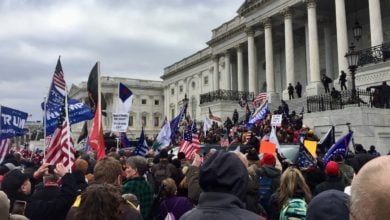Joe Biden’s recently-announced pandemic relief package, the so-called American Rescue Plan, is the new administration’s top legislative priority. With the bar set tragically low by the Trump government, any action at all by the Biden administration may feel like a welcome improvement. But the severity of the pandemic in the country and the threat of emerging, highly-transmissible new strains of the virus requires radical solutions to address the urgent daily needs of working and poor people.
The Democrats control both houses of Congress and the executive branch. The filibuster that requires 60 Senators to vote in favor of closing debate on a measure is not a law, but an internal Senate rule that the Democratic majority can simply decide to do away with. But despite having the power to pass laws without any Republican support, the Biden administration has introduced another bill that fails to measure up to the scale of the crisis facing the working class.
If the United States had just inaugurated a socialist government instead of a pro-corporate Democratic Party administration, it would move to immediately cancel all rent and mortgage payments along with any debt accumulated to landlords and banks. Everyone would be guaranteed a dignified income that allows them to stay home and contain the pandemic. The insurance industry would be abolished and the pharmaceutical giants expropriated to ensure universal access to healthcare, including the vaccine. Despite the eye-catching $1.9 trillion price tag on Biden’s proposal, it does not contain any of these or other sweeping measures necessary to resolve the public health and economic crisis gripping the country.
Healthcare, housing and food
Opinion polling has consistently shown high levels of support for a universal healthcare system along the lines of Medicare for All. Rather than using this historic moment of suffering to put into place what would be an incredibly popular and much-needed reorganization of the U.S. healthcare system away from the for-profit model, Biden refuses to ditch the parasitic insurance companies. The administration’s proposal is to continue to rely on the patchwork system of private insurance markets, but cap premiums at 8.5 percent of one’s income.
Tens of thousands of families have been kicked out of their homes since September 2020 despite the Centers for Disease Control’s national moratorium on evictions issued that month. Biden’s plan calls for an extension of this measure through September 2021 and additionally creates a pool of funds for states and localities to use to assist those who are at risk of homelessness. It remains unclear how Biden’s rental assistance funds would be distributed, except that a minimum of $200 million will be guaranteed to each state and that money in excess of this minimum will be based on population rather than specific need for rental assistance in a state.
This could lead to insufficient assistance in very rental-dense, high-cost areas like the major cities of the country. Also of concern is the fact that funds are intended to be paid directly to landlords, which suggests that it may be difficult for renters to figure out if their back rent or future rent is being covered by the program. States will develop their own application processes and may add restrictions, leading to another patchwork, hard-to-navigate response to this urgent national problem.
Approximately 50 million Americans experienced “food insecurity” — meaning hunger — in 2020, including one in four children. This grave crisis will not be remedied by the bill’s proposal to boost the already-gutted, means-tested food stamp program (SNAP) by 15 percent. Right now most states are issuing the maximum SNAP benefit amount as an emergency measure in response to COVID-19, and the proposed 15 percent increase would result in about $100 extra for an average household of four. But some research has found that especially single-adult households may need more than $100 extra per week in excess of the maximum SNAP benefit to meet basic nutritional needs. Furthermore, increases in emergency federal unemployment assistance will continue to count as income in SNAP eligibility testing, meaning that individuals may find themselves losing their food benefit as a result.
Direct and indirect payments
Biden has faced criticism even from more liberal members of his own party for promising $2,000 direct payments and then really proposing $1,400 checks — which would equal $2,000 when added to the Trump administration’s final direct payout of $600.
Federal unemployment aid could be raised by $100 per week to a total of $400 under Biden’s plan. This figure is less than the $600 per week that the Trump government offered in mid-2020. The enhancement to unemployment benefits would expire in September — unless dramatic improvements are made to the so far shambolic vaccination drive it is highly unlikely the crisis will be over by then.
Federal assistance to state and local governments — amounting to $350 billion under Biden’s proposal — could help large numbers of public sector workers keep their jobs. The same could be true of increased funding for small business assistance programs. But strict oversight will be necessary to ensure that government entities and businesses that receive aid do not find backdoor ways to conduct layoffs, or that highly profitable companies do not exploit loopholes to access aid meant for struggling small businesses.
The new President’s plan to address the needs of children and the deeply impoverished is not to offer direct payments or guaranteed income and employment. Instead, Biden will extend and increase individual tax credits. This will delay the receipt of aid that is needed right now, ensure the disqualification of many undocumented workers, and create barriers to access what is necessary for people whom the capitalist system has failed or excluded.
If we fight, we can win
Part of Biden’s stimulus includes a proposal to institute a $15 an hour minimum wage, end the degrading and outrageously low tipped minimum wage, and do away with the sub-minimum wage that has hyper-exploited the labor of workers with disabilities and made them akin to second class citizens. The increase to $15 would more than double the current federal minimum, up from $7.25 where it has been stuck since 2009.
The demand for a $15 an hour minimum wage has entered the mainstream thanks to the determined fight led by service industry workers that began during the Obama-Biden administration in 2012 and has won victories in many localities since then, including at the state level in Florida as a result of a referendum in the November election. Workers have gone on strike, staged mass demonstrations and popularized a demand that was once scoffed at but is now considered common sense by large sectors of society.
The impressive progress made by the Fight for $15 offers a glimpse of the power of the organized working class. It can serve as an example for how to not only demand but also win more of the reforms that are necessary and overdue for the survival of working and poor people. That same model of determined class struggle can win a monthly income guarantee of at least $2,000 per person, a return-to-work guarantee, a ban on layoffs, a program where the government pays non-essential workers to stay home to reduce the spread of the virus, and so much more.





